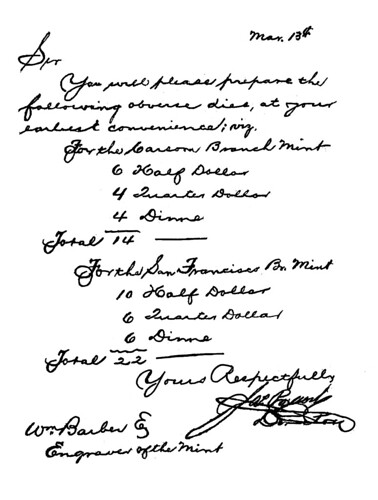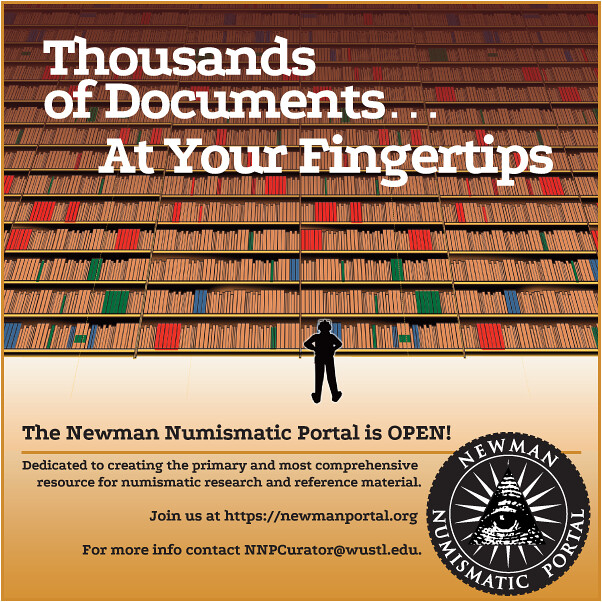
About UsThe Numismatic Bibliomania Society is a non-profit organization devoted to the study and enjoyment of numismatic literature. For more information please see our web site at coinbooks.org SubscriptionsThose wishing to become new E-Sylum subscribers (or wishing to Unsubscribe) can go to the following web page link MembershipThere is a membership application available on the web site Membership Application To join, print the application and return it with your check to the address printed on the application. Membership is only $20 to addresses in the U.S., $25 for First Class mail, and $30 elsewhere. For those without web access, write to: Terry White, Treasurer
AsylumFor Asylum mailing address changes and other membership questions, contact Terry at this email address: terrywhite5475@yahoo.com SubmissionsTo submit items for publication in The E-Sylum, just Reply to this message, or write to the Editor at this address: whomren@gmail.com BUY THE BOOK BEFORE THE COINSale Calendar |
- WAYNE'S WORDS: THE E-SYLUM MARCH 13, 2016
- CNG E-AUCTION #371 FEATURES NUMISMATIC LITERATURE
- NEW BOOK: COIN COLLECTING ALBUMS, VOLUME TWO
- BOOK REVIEW: GOLD DUCATS OF THE NETHERLANDS, VOL. 1
- NEWMAN NUMISMATIC PORTAL DIGITIZES THE CENTINEL
- COIN WORLD: NEWMAN PORTAL WILL BE COLLECTOR'S FAVORITE
- WHO ISSUED THE FIRST CIVIL WAR TOKEN?
- SCRIP COLLECTORS SHOW IN BECKLEY, WV APRIL 29-30, 2016
- NOTES FROM E-SYLUM READERS: MARCH 6, 2016
- BOOKS FOR COLLECTORS OF U.S. COLONIAL COINAGE
- FRANK J. KATEN, (1903-2001)
- LETTER ORDERS 1873 SILVER COIN DIES WITH ARROWS
- FRANKLIN'S PEALE'S EUROPEAN TRIP EXPENSES
- LOU GEHRIG BASEBALL HALL OF FAME PLAQUE
- THE HALF-DOLLAR’S ACCIDENTAL DEMISE
- WAYNE'S NUMISMATIC DIARY: MARCH 13, 2016
- SELECTIONS FROM STACK'S BOWERS MARCH 2016 RARITIES SALE
- FAKE PROOF 2015-W AMERICAN EAGLES SURFACE
- FINDING BAR KOKHBA COINS IN KENTUCKY (OR NOT)
- ALABAMA BRINK'S WORKER STEALS $200,000 IN QUARTERS
- THE HISTORY OF THE NLG'S CLEMMY AWARD
- YOUTH GROUP VISITS BRITISH MUSEUM NUMISMATICS SECTION
- IKEA’S UBIQUITOUS BILLY BOOKCASE DESIGNER DIES
- THE WORLD'S MOST BEAUTIFUL BANKNOTES
- FEATURED WEB SITE: RENAISSANCE OF THE CAST MEDAL
Click here to access the complete archive
To comment or submit articles, reply to whomren@gmail.com
WAYNE'S WORDS: THE E-SYLUM MARCH 13, 2016
New subscribers this week include: Douglas Adams. Welcome aboard! We now have 1,956 subscribers.
I endured a hard drive crash earlier this week but managed to get back on my feet quickly and complete this issue. However, some emails may have been lost. If you've been in touch with me lately and haven't gotten a reply, please resend your note.
This week we open with a numismatic literature sale from CNG, one new book and one review, followed by the latest report on additions to the Newman Numismatic Portal.
Other topics this week include the first Civil War token, coal scrip, literature dealer Frank Katen, an important 1873 letter from the Director of the Mint, the demise of the U.S. Half Dollar, fake proof 2015 American Eagles, the NLG Clemmy award and the world's most beautiful banknotes.
To learn more about the Library of Coins and Treasury of Coins, gold ducats of the Netherlands, Cincinnati die sinker John Stanton, Johann David Schöpf’s Travels, Katen's Koin Kapers, Lou Gehrig's Baseball Hall of Fame plaque, medals by Kauko Räsänen and Sven Havsteen-Mikkelse and Bar Kokhba coins found in Kentucky, read on. Have a great week, everyone!
Wayne Homren
Editor, The E-Sylum
CNG E-AUCTION #371 FEATURES NUMISMATIC LITERATURE
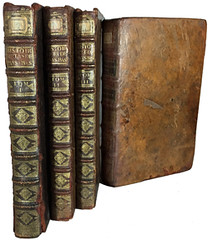
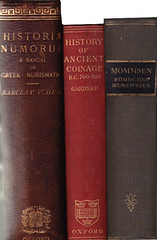
Classical Numismatic Group of Lancaster, Pennsylvania and London, England is proud to present Electronic Auction 371, a special e-sale featuring a broad selection of 1387 book and antiquity lots, opening on 9 March 2016 and closing on 23 March 2016. A vast array of numismatic books and catalogs will be presented from the libraries of Dr. Lawrence A. Adams, J. S. Wagner, J. Eric Engstrom, Dr. Will Gordon, as well as selections from the library of an American ancient coin dealer, and auction catalog and fixed price list duplicates from the American Numismatic Society.
CNG E-Sale 371 contains 994 lots representing approximately 2500 books and auction catalogs, with the primary focus being on ancient, medieval, and world numismatic literature. Titles range from antiquarian to the latest editions of numismatic scholarship.
The American Numismatic Society’s Harry Bass Jr. Library holdings include an almost complete collection of historic auction catalogues. Over the last few years, the ANS has continued to catalogue all of its holdings in the John Adams Rare Book Room, including many duplicate copies of older pre-1945 catalogues. Over the next couple of years, the Society plans to sell its duplicates of hundreds of rare auction catalogues and other duplicate numismatic literature. Curatorial staff used many of the duplicate copies while they were employed at the Society. It is also likely that the ANS Library received gifts from prominent German dealers, as many of the copies are fully annotated with prices. Such auction catalogues are essential for any serious research library, as they allow detailed investigations into the provenance and prices of coins. The Society’s first offering of historic auction catalogues will be in CNG E- Sale 371. All proceeds from this sale will benefit the Society's library acquisition
To view the entire offering of numismatic literature in CNG E-Sale 371, please visit the firm’s website at: http://cngcoins.com/Coins.aspx?CONTAINER_TYPE_ID=2&VIEW_TYPE=0
Also, a downloadable PDF for the numismatic literature listings is available at: http://cngcoins.com/Coins.aspx?CATEGORY_ID=5264&VIEW_TYPE=0
In addition to the comprehensive offering of numismatic literature, CNG E-Sale 371 also features an outstanding selection of antiquities from the collections of J. S. Wagner, David Hendin, Joan Wilde, Dr. Steven Gerson, Frank Kovacs, and Dr. Carl Devries, a noted Egyptologist associated with the Oriental Institute of the University For further details and any additional information, please contact CNG, Inc. at:
Classical Numismatic Group, Inc.
Lancaster, PA 17608-0479
Telephone: (717) 390-9194
Email: cng@cngcoins.com
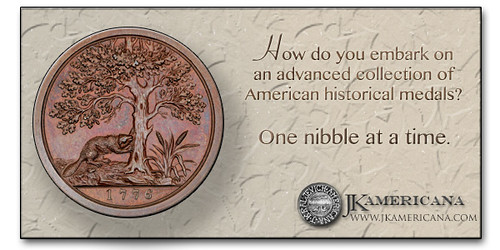
NEW BOOK: COIN COLLECTING ALBUMS, VOLUME TWO
Pre-Publication Offer on Library of Coins Book
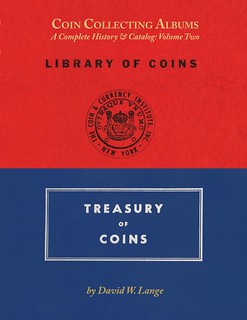 Numismatic researcher and author David W. Lange has written a new book that is being published by his own imprint, PennyBoard Press.™
Listed at $49.95, this deluxe, hardcover, 144-page book is being offered at the pre-publication price of $45 until May 1, the expected date of
delivery. Shipping is $10 for priority mail within a sturdy box.
Numismatic researcher and author David W. Lange has written a new book that is being published by his own imprint, PennyBoard Press.™
Listed at $49.95, this deluxe, hardcover, 144-page book is being offered at the pre-publication price of $45 until May 1, the expected date of
delivery. Shipping is $10 for priority mail within a sturdy box.
Titled Coin Collecting Albums – A Complete History & Catalog: Volume Two, Library of Coins and Treasury of Coins, this book reveals the story behind perhaps the most popular line of coin albums ever produced. Issued from 1959 to 1971, the Library of Coins albums were notable for their extensive list of titles that included all United States coin series by date, mint and varieties, with the exception of gold coins. A complete roster of albums for Canada’s decimal coinage was also offered. No other albums were so thorough in their coverage, and they were the brand of choice for all advanced coin collectors. The brainchild of famed numismatist and dealer Robert Friedberg, these albums were sold primarily through his chain of coin hobby counters that were operated in dozens of department stores around the country from the 1940s until as recently as the 1990s.
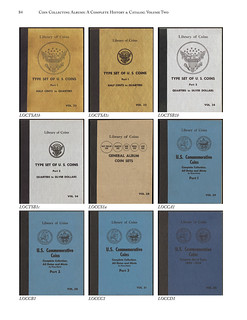 Also detailed in this book is the lesser known line of junior coin albums for beginners that Friedberg marketed as the Treasury of Coins.
Though never as popular as the LOC, the TOC albums have emerged as rarities today and are eminently collectable. Indeed, all of the coin albums
produced by Friedberg’s publishing division, The Coin and Currency Institute, remain desirable today. The LOC albums are still sought by veteran
collectors for the display of their coins, as no comparable albums are currently in production, while the TOC albums are desired as collectors’ items
in their own right by enthusiasts such as the author of this book.
Also detailed in this book is the lesser known line of junior coin albums for beginners that Friedberg marketed as the Treasury of Coins.
Though never as popular as the LOC, the TOC albums have emerged as rarities today and are eminently collectable. Indeed, all of the coin albums
produced by Friedberg’s publishing division, The Coin and Currency Institute, remain desirable today. The LOC albums are still sought by veteran
collectors for the display of their coins, as no comparable albums are currently in production, while the TOC albums are desired as collectors’ items
in their own right by enthusiasts such as the author of this book.
All titles, editions and varieties of each album are fully described and numbered in this book, which includes a 64-page color section illustrating all the products put out by The Coin and Currency Institute. It is a deluxe, hardcover reference similar in quality to Lange’s acclaimed Volume One, which studied the National Coin Album and all of its associated products.
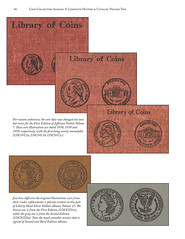
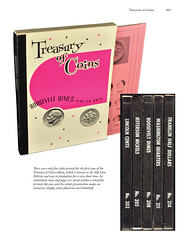
David W. Lange’s new book features much more than simply a catalog of coin albums. Also found within its covers is a biography of Robert Friedberg and his family, as well as histories of his two businesses, Capitol Coin Company and the aforementioned Coin and Currency Institute. The latter still operates under the presidency of Robert’s elder son, Arthur Friedberg, and it’s known for several landmark books that remain in print to this day.
In celebration of his new book, Lange is offering reduced prices for the two previous titles published by his own PennyBoard Press.™ Coin Collecting Albums – A Complete History & Catalog: Volume One, The National Coin Album & Related Products of Beistle, Raymond & Meghrig, published at $75, is now just $49.95. Like the new volume, this nearly 300-page book is a deluxe, hardcover publication that is fully illustrated, including 80 pages in color. Coin Collecting Boards of the 1930s & 1940s: A Complete History, Catalog and Value Guide, published at $39.95, is now being offered at just $19.95.
A collector of coin boards and albums for 35 years, David W. Lange is best known as Research Director for Numismatic Guaranty Corporation in Sarasota, Florida, as well as the author of six popular books on United States coinage and U. S. Mint history. His column, “USA Coin Album,” appears monthly in The Numismatist, the official magazine of the American Numismatic Association.
All books purchased from David W. Lange will be signed, and personalized inscriptions are available upon request. Payment may be made by check made out to David W. Lange or via PayPal to langedw@msn.com.
David W. Lange may be contacted at POB 110022, Lakewood Ranch, FL 34211 or by email at langedw@msn.com His website address is www.coincollectingboards. com, and from this site he also buys and sells vintage coin boards and folders. A new website for his publishing imprint, www.pennyboardpress.com, is currently under preparation.
BOOK REVIEW: GOLD DUCATS OF THE NETHERLANDS, VOL. 1
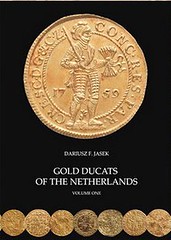 Book Review by Michael E. Marotta
Book Review by Michael E. Marotta
Gold Ducats of the Netherlands, Vol. 1 by Dariusz F. Jasek, Knight Press, 2015. 345 pages, A4 (11.7 x 8.3 inches) €135 from www.goldducats.com.
I saw Gold Ducats of the Netherlands by Dariusz F. Jasek mentioned on the CoinTalk.com discussion board. From the sample material provided in the links, the book looked like a quality presentation. So, I bought the book in order to review it. I do not collect the series.
In the first place, when opened, the book lays flat. The binding is truly perfect –bound to the highest standards. The illustrations include high quality photographs of every coin (where possible), as well as specially commissioned line art to complement the narrative.
Perhaps the most telling hallmark is the fact that this is the book that the author wrote for himself. Fascinated by the long series of gold ducats of the Netherlands, Dariusz Jasek compiled a database of known images and descriptions. He arranged for permission for 3,000 images and supporting text from CoinArchives.com, and he obtained license to another 3,000 from the official database of the recently uncovered Koice Gold Treasure housed in Krakóv, Poland. To those he added 17,000 from auction houses and other sources. This book rests on a monumental database of over 23,000 known examples. The author brings passion and precision to this remarkable series of coins.
This is far more than a catalog. The actual listing of coins, by mint, denomination, and year, takes up the last 240 pages. The first quarter of the book, 90 pages, is about the history, purchasing power, and minting technology of the coins.
I spent a weekend reading the text, and catching typographical errors. They are inevitable. In software, we say that every non-trivial program has at least one bug. So, museum’s for museums was not the end of the world.
Like every cultural artifact, money exists in a social context. The author places this important series of gold coins in its historical milieu, tied closely – intimately – with the Dutch East India Company: Vereenigde Oost-Indische Compagnie, commonly initialized as VOC. This was the first joint-stock corporation, and (perhaps arguably) the first multinational corporation. Even after it was closed by law in 1799, the coins that were so closely associated with it continued – as well they should, as they began a century before the VOC was chartered. The VOC was beset by many problems, internal perhaps more than external. It was a wry comment that VOC was parodied as “perished by corruption”: Vergaan Onder Corruptie.
Whatever corruption touched the Dutch East India Company, since 1586, the ducats were kept consistent in weight and fineness - 3.515 grams and 0.986 fine. Both were lowered slightly in 1817 (3.454 grams and 0.983 fine), but those metrics have not changed in 200 years.
The Netherlands gold ducat was an imitation – a sibling, not a usurper – of the ducats of Venice and Florence. The closest cousin was the gold ducat of Hungary. The coin was struck for official and commemorative agendas from the 16th through the 21st centuries. Those and others are all illustrated and catalogued in this book. At root, while acknowledging the broad latitudes of issuance, this book is about the historically relevant coins of the 16th, 17th and 18th centuries, including piedforts and klippes. In addition to this book, the author includes a 50-page booklet (5-1/2 x 8-1/2), Estimated Values and Die Marriages. The values are recent updates to the figures published in the catalog. Those are all supported by citations to recent auctions.
This is the first volume of a multi-volume set. The next book is in production now.
To read the earlier E-Sylum article, see:
NEW BOOK: GOLD DUCATS OF THE NETHERLANDS
(www.coinbooks.org/esylum_v18n41a04.html)
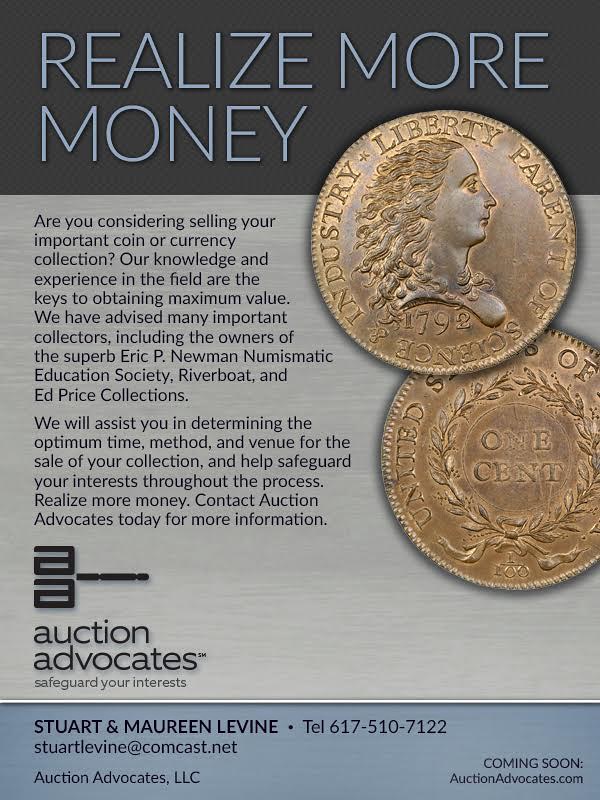
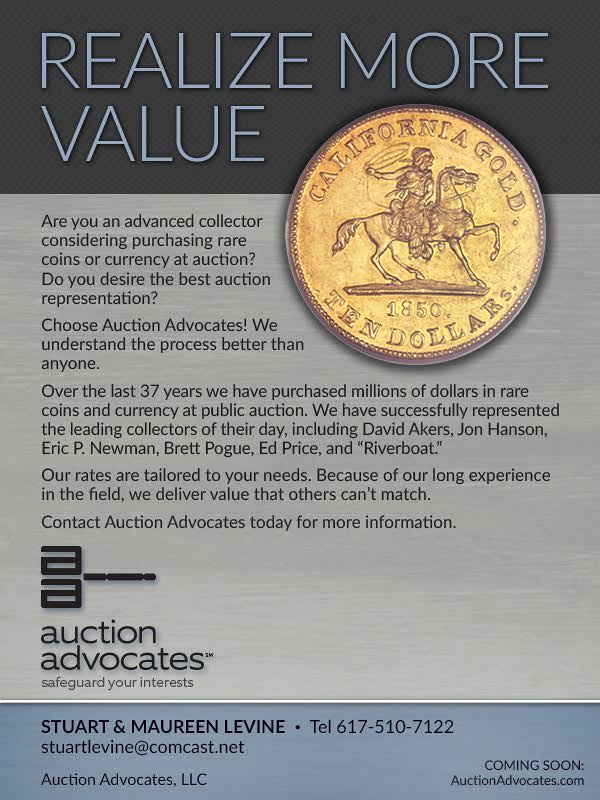
NEWMAN NUMISMATIC PORTAL DIGITIZES THE CENTINEL
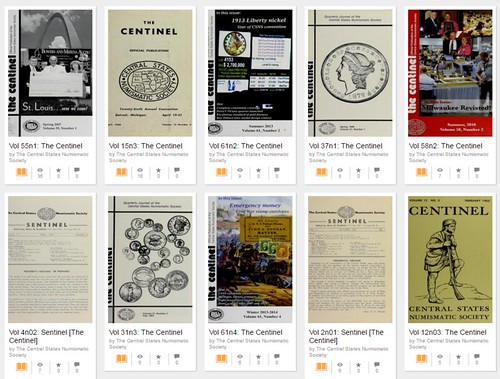
The journal of the Central States Numismatic Society (CSNS), The Centinel has been continually published since 1953 and is currently under the capable editorship of Gerald Tebben. CSNS Treasurer Jack Huggins recently delivered the back issues of this journal to the Newman Portal scanning center in St. Louis, and this periodical, through the year 2013, is now available on the Newman Portal. The Centinel represents an extensive archive, with over 200 individual issues and 10,000 pages in total. Scanning began on February 17 and concluded on March 4. Regional publications often feature significant numismatic content but are little known outside their geographical area.
A quick browse in The Centinel, for example, reveals an important article in the Winter 1995 issue (vol. 43, no. 4), by Robert Vassell, discussing the formation and disposition of the Byron Reed collection in Omaha, NE. No doubt there are hundreds of similar tidbits in this longstanding publication.
The Newman Portal acknowledges Bruce Perdue (CSNS President) and Jack Huggins (CSNS Treasurer) for their assistance with this project.
To read the complete article, see:
http://www.newmanportal.org/library/publisherdetail/511275
To read the Robert Vassell article on the Byron Reed collection, see:
www.archive.org/stream/centinel43n4cent#page/14/mode/2up
COIN WORLD: NEWMAN PORTAL WILL BE COLLECTOR'S FAVORITE

There has never been a better time to be a numismatic researcher, thanks to the growing presence of classic numismatic literature made available online.
As senior editor Paul Gilkes reports on page 4 this week, the Newman Numismatic Portal is now open to the public, with a growing number of classic books, auction catalogs, government reports and more now accessible online at no cost. The concept is being “funded by the Eric P. Newman Numismatic Education Society and administered through Washington University in St. Louis. The focus of the portal is to provide the most comprehensive numismatic research tool available online,” Paul reports.
If you didn’t know Eric Newman, father of the project, you might think that a 104-yearold man would be the last person who would champion an Internet resource. We all have older relatives (like my own mother) who have never gone online or used a computer, so it wouldn’t be a surprise that a man born before the opening of World War I might not embrace the digital age. But Eric Newman has, and we all benefit.
The Newman Numismatic Portal is one of the most significant contributions to the hobby in years and has the potential to be one of the most important tools any numismatists could access. It will offer casual collectors, advanced researchers, and historians from outside the numismatic community an immense treasure trove of research materials. Here is a list of titles already available to read (for free): A Manual of Gold and Silver Coins of all Nations by Jacob Reese Eckfeldt; Illustrated History of the United States Mint by George Greenlief Evans; Dates of United States Coins and their Degree of Rarity by Joseph Jacob Mickley; Guide to the numismatic collection of the Mint of the United States at Philadelphia, Pa. by Thomas Louis Comparette; and Rare American coins: their description, and past and present fictitious values by E. Locke Mason.
I think it is safe to say that most numismatists love books and auction catalogs and original manuscripts, but until now, access to major works was often limited. That’s no longer true. The Newman Numismatic Portal is continually adding content, including auction catalogs, other 19th and 20th century books and much more. Every collector should bookmark the page in his or her online browser (right next to your bookmark for www. coinworld.com) and make it a regular stop during your day’s online reading experience
To read the complete Paul Gilkes article, see:
Newman Numismatic Portal
now open to public to conduct research (www.coinworld.com/news/us-coins/2016/03/newman-numismatic-portal-
for-research-goes-public.html)
To visit the Newman Numismatic Portal, see:
www.newmanportal.org
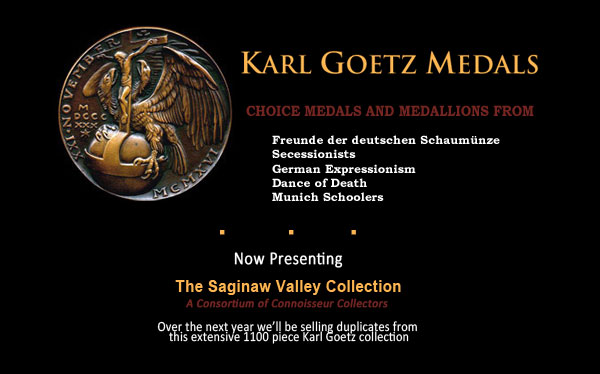
WHO ISSUED THE FIRST CIVIL WAR TOKEN?
In the fall of 2015 I sought to write an article for The Civil War Token Journal (which was published in our Winter 2015 edition) dismantling the misunderstanding that H.A. Ratterman was the first issuer of Civil War token store cards. It bothered me to no end that the internet seemed to copy and paste exactly what Wikipedia had on the topic. I saw on site after site, some seemingly authoritative, others simply glorified advertising and internet marketing sites, the Wikipedia entry verbatim.
The entry is as follows: “The first of these privately minted tokens [referring to Civil War token store cards] appeared in the autumn of 1862, by H. A. Ratterman, in Cincinnati, Ohio.”
This lead me to two logical conclusions. The first is that I need to be more active as an editor on Wikipedia to correct information that is either outdated or largely misunderstood. The second is that numismatists are still valuable resources in the wild west of interpreting our collective history.
For some background, the statement that is copied verbatim is from a real source. It comes from an interview in 1910 in The Numismatist with Ratterman himself, conducted by Waldo C Moore. I ask you to refer to my article in the Winter 2015 journal for a look at the entrepreneurial and ambitiously self-righteous attitude of H.A. Ratterman.
He was a numismatist and in addition to being a jack-of-all-trades renaissance man. He clearly made the statement that he conceived the idea for store cards in order to add to his already historic place in German-American, Cincinnati, architectural, literary, antiquities appreciation, and numismatic culture.
In the interview, he reasoned he came up with the idea for producing them. At the time of the interview, no one was taking responsibility for their issue, but clues were emerging from Cincinnati due to the sheer quantity and variety coming out of the Queen City.
Numerous numismatists (Bowers, Jaeger, Ostendorf) firmly agree on Cincinnati die sinkers being one of the earliest to implement the store card trend successfully, but not the first to produce them. The evidence they cite seems to suggest Chicago and Indiana die sinkers for local merchants.
The greatest evidence against Ratterman comes from prominent Cincinnati die sinker John Stanton, famous for his Wealth of the South tokens, writing at the age of 82, that he did not conceive the idea for store card production until he saw them in circulation in Indiana; “very early in the War of Rebellion.” Even if we consider the date of the above source, April 1862, we know there were issues prior to that.
This makes for a classic example for young researchers and budding historians: just because it is in the history from a primary source does not mean that it should be automatically plugged into research, and like in this case, the source actually inaccurate. The result leads to dozens of websites and other published media inaccurately feeding information to the public.
To read the complete article, see:
Who Issued the
First Civil War token? Dismantling the Copy and Paste Research Culture (http://scottmhopkins.com/who-issued-the-first-civil-war-token-
dismantling-the-copy-and-paste-research-culture/)
SCRIP COLLECTORS SHOW IN BECKLEY, WV APRIL 29-30, 2016
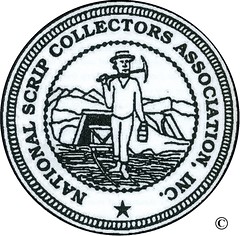 The National Scrip Collectors Association (NSCA) will hold their semi-annual Spring Show in the heart of coal country in Beckley on Friday
and Saturday, April 29 & 30, 2016 in the Appalachian Room at the Country Inn & Suites. The Spring Show draws scrip collectors and dealers from all
around the United States to discuss and share knowledge of all aspects of scrip collecting, from new finds, to historical insights, and first person
accounts from coal miners and family members.
The National Scrip Collectors Association (NSCA) will hold their semi-annual Spring Show in the heart of coal country in Beckley on Friday
and Saturday, April 29 & 30, 2016 in the Appalachian Room at the Country Inn & Suites. The Spring Show draws scrip collectors and dealers from all
around the United States to discuss and share knowledge of all aspects of scrip collecting, from new finds, to historical insights, and first person
accounts from coal miners and family members.
Tables will be set up where scrip can be bought, sold and traded. Collectors can also take the opportunity to experience some of what life was like in the coal fields at the Beckley Exhibition Coal Mine. The meeting room is reserved from 8:00 AM to 10:00 PM on both Friday and Saturday. A special room rate of $89 has been graciously offered to NSCA members by the hotel. The Country Inn & Suites by Carlson is located at 2120 Harper Road, Beckley WV, 25801 and may be reached by phone at 304-252-5100.
ABOUT SCRIP
– Scrip, whether paper or metal, was, in general, a form of credit extended by an employer against the employees future earnings (not
unlike a debit card), a form of currency intended for redemption only in the employer's company store, or commissary, for the purchase
of food, clothing, tools and equipment, basically everything needed for daily life in the remote coal or lumber camps of the day. Various
forms of scrip were used by virtually every industry in the nation over a broad period of America's industrial history, but played an
especially lengthy and important role in the coal and lumber
ABOUT THE NSCA
– The National Scrip Collectors Association was officially organized as a charitable and educational non-profit corporation on October 21,
1972 at Fayetteville, West Virginia. The NSCA’s objectives are to promote the collection of coal company store scrip (metal or paper) and
related tokens; to cultivate the good relations between collectors of scrip tokens; and to encourage the study and research of the history
of coal mining companies and company stores as it relates to the people of mining communities in the Scrip era.
Through its publishing efforts, the NSCA has been on the forefront of cataloging and recording the history of the scrip used by the coal companies and company stores throughout most of the late nineteenth and twentieth centuries. Coal mining has played a critical role in the industrial growth of the United States and these relics used by the coal miners provide a tangible link to their dedication as well as mute testimony to this often still dangerous line of work. The Edkins Catalog of United States Coal Company Store Scrip, published by the NSCA in four editions over the past half century has proven to be the benchmark work on the subject and lists almost 20,000 different pieces from all the coal-producing states, a number that grows each year. The Edkins catalog is the product of many years of devoted collectors and coal mining enthusiasts dedicated to preserving this aspect of American history.
For information on the NSCA, the history of coal scrip, and membership, please visit us at
http://nationalscripcollectors.org
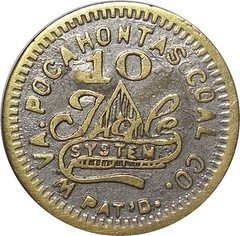
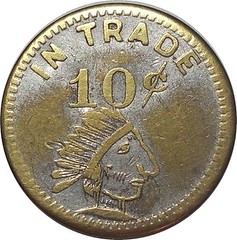
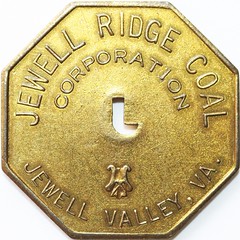
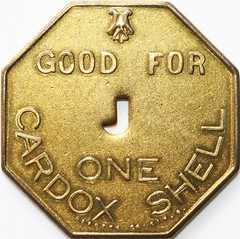
THE BOOK BAZARRE
NOTES FROM E-SYLUM READERS: MARCH 6, 2016
Can Banknotes Be Counterfeited With 3D Printing?
Former American Numismatic Association Executive Director and former Director of the Bureau of Engraving and Printing Bob Leuver
writes:
I read the starling short disquisition on 3-D printing of coins. I re-read it several times. Then, I thought a bit. 3-D printing of plastic currency....
Plastic currency, I believe, is a production that uses layers and binds these layers together. If so, am I reaching too far to assume that plastic currency can be counterfeited by 3-D printing?
I recall a reply by an E-Sylum reader in the Far East, who stated that the Chinese were counterfeiting plastic currency. After that I asserted it would be difficult to counterfeit such currency.
Now, 3-D printing!
To read the earlier E-Sylum article, see:
3D PRINTING IMPOSSIBLY HIGH RELIEF PRECIOUS METAL COINS
(www.coinbooks.org/esylum_v19n10a22.html)
More on the "UFO" Jeton
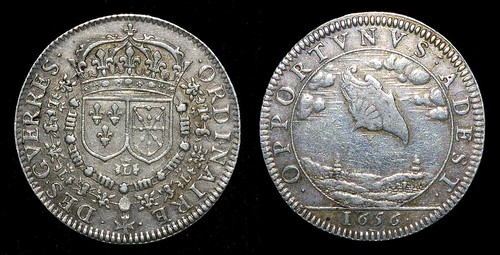
Bill Hyder writes:
My UFO Jeton {Feuradent 420) was issued in 1656 to the Army Accountants (ORDINAIRE DES GVERRES) and the shield side legend, OPPORTVNVS ADEST (Opportune Appearance), clearly indicates the shield protecting the French countryside in my opinion since the accountants were responsible for raising the funds to pay for the army. Another rare jeton (which alas I do not own) shows one of these shileds leaning against a wall along with other weapons. Yes, it is a shield, but it is fun to say you own proof of ancient UFOs!
To read the earlier E-Sylum article, see:
"UFO" JETON RESURFACES IN POPULAR MEDIA
(www.coinbooks.org/esylum_v19n10a19.html)

BOOKS FOR COLLECTORS OF U.S. COLONIAL COINAGE
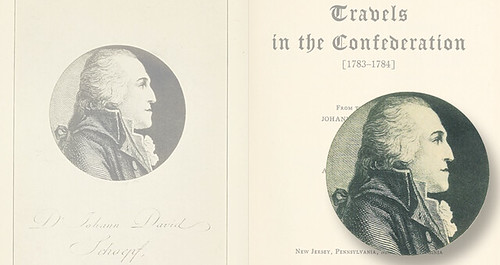
Johann David Schöpf’s Travels in the Confederation
has the first reference to John Chalmers’ Annapolis mint.
A Colonial coin collector’s library is never complete. Once standard references are acquired and all the auction catalogs for famous collections are safely in hand, curious specialists can expand their libraries in every possible direction: forward, backward, and outward.
Forward: There is no time like the present. The last year has seen two new works published by the Colonial Coin Collectors Club.
Chris McDowell’s biography on Abel Buell has placed one of the artisan geniuses of the Confederation and early Federal period in an all-encompassing context. Syd Martin’s new book on French colonial copper coinage shines a spotlight on one of the corners of Colonial numismatics that has been dark for too long.
The Internet, including archival sites like Google Books and the Newman Numismatic Portal, keeps making research easier than it’s ever been, enabling prospective authors to gather data and refine their arguments in months.
While there is no substitute for dusty libraries, shoe leather, and looking at thousands of coins, look for the Information Superhighway to keep making it easier to stock your shelves with new print works every year.
Backward: Most collectors would agree that the modern era of research on Colonial coins started when Sylvester Crosby published The Early Coins of America in 1875.
Some books are vital to understanding the coins and why they circulated in America, like Jonathan Swift’s Drapier’s Letters, which described the creation and rejection of William Wood’s halfpence. Early travelogues are important sources, like Johann David Schöpf’s Travels in the Confederation, which provides the first reference to John Chalmers’ Annapolis mint. Magazines and newspapers in both Europe and America include descriptions or even illustrations of coins while they still circulated.
In the 1850s, as coin collecting was blossoming in America, Colonial coins became a topic of interest, and periodicals like Historical Magazine offered space to collectors like Jeremiah Colburn and Augustus Sage to share what they had learned.
Outward: For as broad as the field of numismatic literature is, it is ever expanding. Push beyond the confines of books written about coins by coin people, and you’ll find archaeologists recording coins they’ve dug, economists discussing the circulation of foreign coins or the prominence of paper money, and famous biographers hanging flesh on the founders without whom these coins wouldn’t exist.
To read the complete article, see:
Seeking completion to one's
numismatic library: Colonial America (www.coinworld.com/news/us-coins/2016/03/let-bibliographies-be- your-guide-kraljevich.html)

FRANK J. KATEN, (1903-2001)
Francis “Frank” Joseph Katen, (1903-2001), his real name is Francesco Giuseppe Cincinnati Catanzariti. He was born on January 21, 1903, the son of Rocco Antonio Catanzariti (1870-1917) and Ataliana Labianca (1883-1976) in Plati, Catanzaro, Calabria, Italy. However, several birth records report him born in New York.
Sometime between 1915 and 1925, when Italians were treated very unfair and biased especially during the case of Sacco and Vanzetti he changed his name to Katen.
He began dealing coins five years after the death of [his first wife] Ruby in 1938 through his novelties company.
He joined the ANA in 1942 and in February was given ANA Member No. 8920. He had married Frances M. Katen (1911-) about this time. His mailing address at that time was 18 Pearl Hill, Milford, Connecticut.
In January 1945 he opened a shop at 486 State Street, New Haven, Connecticut. He ran a full page advertisement for his coin shop selling German Notgeld in January issue of The Numismatist, page 68.
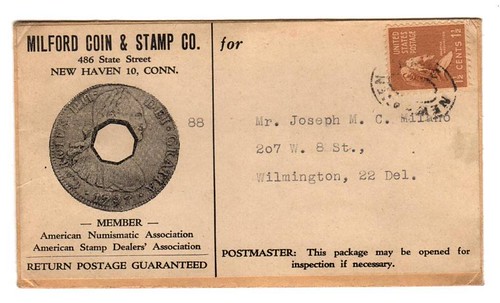
In April 1945 he named the shop Milford Coin & Stamp Co. 487 State Street, New Haven, Connecticut, which he ran under that name until sometime between 1964 and 1966. He was one of the founders of the American Coin Dealer's Association.
In March, 1950, he was brought up on charges of reporting irregularities in ANA elections from 1948 to 1949. He was expelled from the ANA in August 1950, still trading as Milford Coin & Stamp Co. From this controversy he began publishing a series of articles in his coin auction catalogues titled: Koin Kapers. The series was reprinted into a single pamphlet titled: Let There Be Light.
During the summer of 1951 ... he moved to Europe with his second wife Frances M. Katen for a little over a year returning about October 1952. He opened a coin, numismatic literature shop, and mail order business at 1726 Upsher Street, NW, Washington, D. C., running his first ad in the November 1952, Numismatic Scrapbook.
He then married divorcee Laurese Byrd Boone Pusey (1917-2014). She was a dog breeder raising Schnauzers.
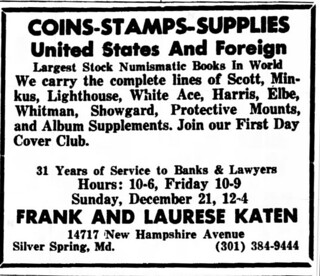 During that period Frank and his wife Laurese worked side by side in the coin shop. They began to focus on the use and sale of numismatic
literature.
During that period Frank and his wife Laurese worked side by side in the coin shop. They began to focus on the use and sale of numismatic
literature.
From 1966 to 1997 the coin auction sales no longer were part of the Milford Coin and Stamp Company but became the new business trading as Frank and Laurese Katen.
He died January 21, 2001. ANA Life member 132. He is buried in Gate of Heaven Cemetery in Silver Springs, Maryland.
Laurese died on December 12, 2014 at her home 147i7 New Hampshire Avenue, Silver Spring, Maryland and is also buried in Gate of Heaven Cemetery in Silver Springs, Maryland.
Other E-Sylum readers knew the Katens as well. Any stories to share? -Editor
To read the complete article, see:
KATEN, FRANK
JOSEPH (https://sites.google.com/site/numismaticmallcom/encyclopedic- dictionary-of-numismatic-biographies/katen-frank-j)
THE BOOK BAZARRE
LETTER ORDERS 1873 SILVER COIN DIES WITH ARROWS
Sir
You will please prepare the following obverse dies, at your earliest convenience; viz.
For the Carson Branch Mint
6 Half Dollar
4 Quarter Dollar
4 Dime
–––––––
Total 14
–––––––
For the San Francisco Br. Mint
10 Half Dollar
6 Quarter Dollar
6 Dime
–––––––––––
Total 22
––––––––––––
Yours respectfully
Jas. Pollock
Director
[To]
Wm. Barber E[sq]
Engraver of the Mint
FRANKLIN'S PEALE'S EUROPEAN TRIP EXPENSES
I retrieved a copy this week of Pennsylvania History, published by Pennsylvania Historical Association, July 1951. It contained an article on Franklin Peale and his two-year trip to Europe. His instructions were to learn the technology of European mints with the goal of implementing this technology in the 40-year old Philadelphia Mint.
We learn that in 1833 Mint Director Samuel Moore, with this trip in mind, had hired Peale who had extensive mechanical knowledge. Moore got the approval of Treasury Secretary Louis McLane later that year. McLane authorized the payment to Peale for the trip expenses.
The amount was $7,000. That’s $196,000 in today’s money!
Interesting the Treasury will spend many times that amount now days to consultants to learn there is no metal substitute for copper in cents, or that that steel is not a satisfactory coinage composition for quarters. America got better value for their money to Peale in 1833 than what they spend today.
To read the earlier E-Sylum articles, see:
PEALE REPORT TRANSCRIPTION SOUGHT (www.coinbooks.org/esylum_v18n50a20.html)
CAN YOU READ FRANKLIN PEALE’S HANDWRITING?
(www.coinbooks.org/esylum_v19n09a11.html)
WHERE ARE THE PEALE REPORT DRAWINGS?
(www.coinbooks.org/esylum_v19n10a18.html)
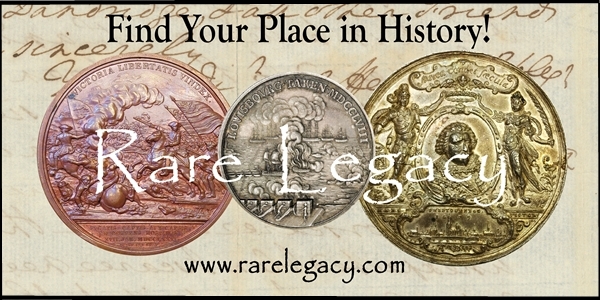
LOU GEHRIG BASEBALL HALL OF FAME PLAQUE

New Jersey’s leading estate-auction specialist, Sterling Associates, made headlines with its January 11th sale of Alexander Hamilton’s personally engraved powder horn. On March 23rd, the Bergen County, N.J., company will shine a spotlight on another great American hero, baseball legend Lou Gehrig. The star lot of their auction is a bronze bas-relief plaque adornment in the likeness of Gehrig that was designed and cast by artisan George Seaman and colleagues at the Steinmeier Bronze Tablet Co., in 1939, the year of Gehrig’s retirement.
As stated in a letter of provenance from Seaman’s son that accompanies the lot, the sculptural work is a contemporaneous casting of the one affixed to Gehrig’s plaque at the National Baseball Hall of Fame and Museum in Cooperstown, New York.
“The Steinmeier foundry in New York City produced the Lou Gehrig bronze for the actual Hall of Fame plaque. The example we are auctioning was made at the same time a s a gift for Seaman’s son, who was a big Lou Gehrig fan. To the best of our knowledge, this was the only additional casting,” said Sterling Associates’ owner, Stephen D’Atri.
Baseball’s legendary “Iron Horse” was the first Major League Baseball player to have his uniform number (“4”) retired. He played 17 seasons with the New York Yankees, starting in 1923, and voluntarily ended his career after being diagnosed with ALS, later known as Lou Gehrig’s Disease. His lifetime batting average was a remarkable .340. “Gehrig’s career achievements and professionalism made him one of baseball’s immortals. To this day, he is idolized by Yankee fans,” D’Atri said.
The bronze sculptural depiction of a smiling Gehrig in a tableau adorned by two baseball bats and a laurel branch, measures 7 inches high by 12 inches wide. It is mounted on a wood plaque. The conservative auction estimate is $3,000-$5,000.
To read the complete article, see:
Bronze Lou Gehrig "Baseball Hall of Fame" casting, fine jewelry headline Sterling Associates' March 23 sale
(http://artdaily.com/news/85738/Bronze-Lou-Gehrig--Baseball-Hall- of-Fame--casting--fine-jewelry-headline-Sterling-Associates--March-
23-sale#.VuWWnOIrLrc)
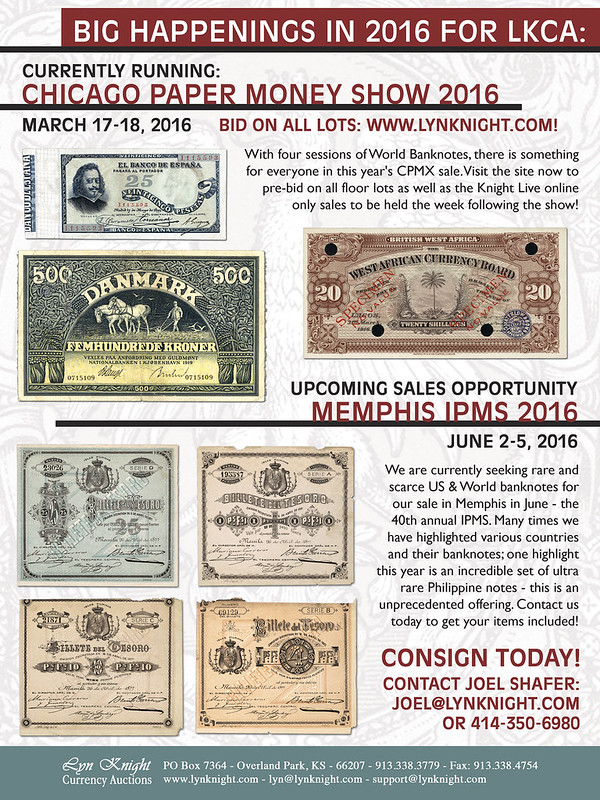
THE HALF-DOLLAR’S ACCIDENTAL DEMISE
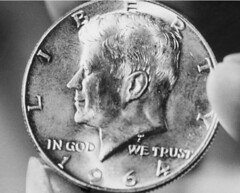 Former Treasury Secretary Lawrence H. Summers recently suggested stopping the production of $100 bills, ostensibly to deprive criminals of
their favorite form of cash.
Former Treasury Secretary Lawrence H. Summers recently suggested stopping the production of $100 bills, ostensibly to deprive criminals of
their favorite form of cash.
Mr. Summers may or may not get his way. But here’s a potential trade-off: If the hundred-dollar bill is destined to vanish from cash registers, how about bringing back one of the jauntiest denominations of American spending money, one that many citizens, through no fault of their own, have never felt in their pockets: the 50-cent piece?
This year, the U.S. Mint will manufacture for public circulation—if recent numbers are a guide—around nine billion pennies. The mint will produce around two-and-a-half billion quarters, almost three billion dimes and a billion-and-a-half nickels.
The number of 50-cent pieces that the mint will manufacture and release for general circulation in 2016 is the same it has been for the past 13 years: zero.
No one saw the half-dollar’s demise coming. The disappearance from everyday usage of what once was a taken-for-granted, constantly present American coin is a tale of unintended consequences, and of how history can blindside and do away with even the most standard and noncontroversial aspects of the nation’s life.
The 50-cent piece was always a highly useful, immensely popular coin. The thing had heft and a bit of swagger: It was bigger and heavier than the smaller-denomination coins, but not so unwieldy that it was uncomfortable to carry. There was a touch of ring-a- ding-ding to having it in your pocket. You had to resist the impulse to pull it out and flip it.
And—most important—you could make significant daily purchases with it, and walk away with change. The mint had been putting half-buck pieces into circulation for as long as the U.S. had been manufacturing coins; by the early 1960s, a 50-cent piece would buy you a quart of milk, or an issue each of Sports Illustrated and Life magazines, or enough Snickers bars and packs of Beech-Nut Spearmint gum to get you and a couple of buddies through the afternoon, or a gallon-and-a-half of gas, or a bleacher seat at a big-league baseball game. It was real money. Its future seemed secure.
Then, in November 1963, President John F. Kennedy made his trip to Dallas.
As the nation grieved in the weeks after the assassination, government leaders scrambled to come up with ways to honor Kennedy’s memory. President Johnson and Congress thought it would be a fine idea to speedily replace Benjamin Franklin’s face on the 50-cent piece with Kennedy in profile. A touching gesture. What could go wrong?
By February 1964 the Kennedy half-dollars were being pressed, with public release scheduled for March. As soon as banks began offering the coins, long lines formed. People wanted them, all right—not to spend, but to keep. Banks had to ration, limiting the number that individuals could request. A mystique instantly grew. If you had one of those coins, you knew to hold on to it.
Coincidentally and concurrently, the price of silver was rising to the point at which the worth of the material within the 50-cent piece might soon surpass the face value of the coin. Precious-metal traders were hoarding half-bucks, both the new Kennedys and the old Franklins, in anticipation of melting them down and profiting.
The coins seemed to all but evaporate from the public scene. The U.S. Mint, by 1971, had eliminated silver from the composition of the half-dollars, but by then people had become accustomed to their absence. As the years went by, stores stopped making space in cash- register drawers for them; vending machines wouldn’t accept them; banks had to request them from the Federal Reserve for the few customers who desired them; and younger Americans were unaware the coins even existed.
The mint stopped putting half-dollars into circulation in 2002. It still manufactures commemorative and special-edition 50-cent pieces for collectors, sold to the public at a premium, but when the mint offers a mounted set of four Kennedy half-dollars for $99.95, you’d feel like a fiscal idiot spending the coins at the corner 7-Eleven.
The man described by mint officials as the nation’s leading authority on the history of coins, Q. David Bowers, said that, in terms of daily commerce, the half-dollar isn’t coming back. “It’s a dead issue,” he told me. Had the government never removed Ben Franklin’s portrait, the 50-cent piece would likely still be thriving today, as utilitarian and ubiquitous as the George Washington quarter. But—no one planned it this way—it turns out that a coin can be so popular that it goes out of business.
To read the complete article (subscription required), see:
The Half-Dollar’s
Accidental Demise (http://www.wsj.com/articles/the-half-dollars-accidental-demise- 1456695824?cb=logged0.6362204554050646)
WAYNE'S NUMISMATIC DIARY: MARCH 13, 2016
On Tuesday the 9th the March 2016 meeting of my northern Virginia numismatic social club Nummis Nova was hosted by Tom Kays at an Italian restaurant in Springfield called Osteria Marzano. It's a sleekly designed space in an office building in an office park not far from the Capitol Beltway.
I work nearby and arrived early. As I pulled into a space in the parking garage another early bird in the next vehicle waved to me - it was Howard Daniel. We made our way inside about 6pm to the nearly deserted restaurant where the staff was working to put our tables together. We took our seats and began reviewing the menus, but not before Howard had teased and charmed our waitress, Marisol.
Howard brought with him the manuscript for his next book on Southeast Asian coinage. It was a well-organized binder of pages in sheet protectors, a mix of draft pages and photocopies or scans of source material found during his research.
Among the next to arrive were Eric Schena, Dave Schenkman and Gene Brandenburg. All three sat at our end of the table, and they were soon joined by Joe Esposito and Mike Packard. At the other end of our corner of the restaurant were Jon Radel, Tom Kays, Joe Levine, and Steve Bishop. Among the last to get seated in a table the staff slid into the middle were Julian Leidman (at my left) and across from him my guest, Robert Hoppensteadt.
I passed out a few next business cards for NBS advertising The Aslum and The E-Sylum. They were nicely designed by Maria Fanning, and I've also been using them as an ad within The E-Sylum in recent weeks.

Among the first numismatic items passed around were some gargantuan medals from Jon Radel. These were HEAVY, and for perspective on their size, I took this picture next to a quarter from my pocket.
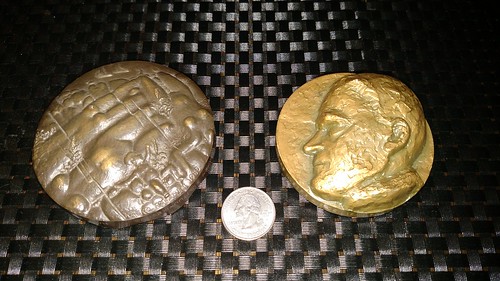
Medals by Kauko Räsänen and Sven Havsteen-Mikkelsen
Jon writes:
The impetus for bringing these medals was in part a joking response to some medals seen at dinner a few months ago where there had been discussion about how nice high relief is, so let's start with the one on the right. It is a 1980 homage to the 100th anniversary of the birth of Ejnar Mikkelsen (1880-1971), a Dane best known for his polar explorations, in particular those of Greenland. The reverse of the medal is a comparatively undistinguished map of Greenland, which led to discussion about medals with wonderful obverses and reverses where about all you can say is "Well, whatever."
The artist is Sven Havsteen-Mikkelsen (1912-1999) who took the subject as a foster father after his parent's marriage disintegrated, eventually adding "Mikkelsen" to his own name; consequently a very personal medal. At the same time, it is a relatively "commercial" medal, having been issued in an edition of 2000 by Anders Nyborg A/S, most famous (in medals, at least) for the Nordic Art Medal Series. See the Spring 2013 issue of The Medal for more on that enterprise. And the high relief? The diameter is 70mm and the thickness is about 24mm at the height of the portrait.
The medal on the left is by Kauko Räsänen (1926-2015), a Finnish sculptor/medal artist whom I suspect has better name recognition in the U.S. than any other other Finnish medalist, probably due to a combination of his being the second non-American to win the Saltus Medal Award in 1986, and his pioneering work in multi-component medals.
The shown medal was issued in 1985 in honor of the Hanasaaren Kulttuurikeskus ( Hanasaari Swedish-Finnish Cultural Centre) inaugurated in 1975 on an island near Helsinki in honor of Swedish/Finnish relations. This one was issued in an edition of 300 in bronze, including this example, and 10 in silver. Someday I hope to get a better feel for whether the side not shown, which shows a tiny island with trees on the horizon, and a tiny sailboat, with many waves, is in part a joking response to early controversy about the chosen site being too remote and hard to reach. Apparently, by the time the center was built, everyone was happy and it has remained a robust presence in the Finnish cultural life.
Thanks! I brought two books with me to the meeting: the new edition of Virginia Tokens and Mike Shutty's new Lost Cents, Dead Owners.
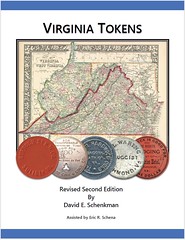
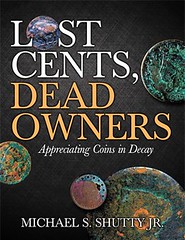
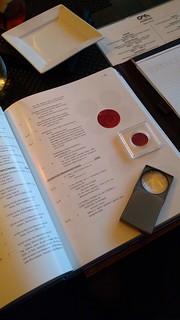 Eric Schena took the seat next to me, which was convenient because I had some questions for him about the new edition of Virginia
Tokens - I'm writing a review of it for the TAMS Journal. Eric handled the book's editing and layout, and contributed research and
images.
Eric Schena took the seat next to me, which was convenient because I had some questions for him about the new edition of Virginia
Tokens - I'm writing a review of it for the TAMS Journal. Eric handled the book's editing and layout, and contributed research and
images.
The majority of the tokens illustrated in the book are in Dave and Eric's collections, and all of the modern images of the issuing storefronts were taken by Eric, who has made pilgrimages around the state to visit some of the sites. Some of these visits (many of which were very fruitful) have been described in earlier E-Sylum issues. There's no substitute for shoeleather in numismatic research.
Eric brought along a neat piece of cardboard scrip with a Half Dime denomination. It's illustrated in the Virginia Tokens book, and I took this photo of it laying on the page where it's illustrated.
Eric writes:
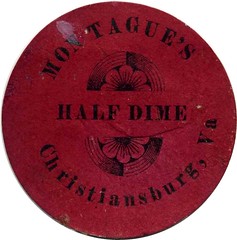 I brought two things of interest for folks to see. The first item is a so far unique half dime token from Christiansburg, Virginia. I have
been following the discussion on half dime tokens in The E-Sylum and can at least offer up this piece. Cataloged in Dave Schenkman's
revised second edition of Virginia Tokens as C2380-M5-5, this red cardboard token was apparently issued by either J. W. Montague or J. K.
Montague, who operated a general store from between 1866 and sometime before 1920.
I brought two things of interest for folks to see. The first item is a so far unique half dime token from Christiansburg, Virginia. I have
been following the discussion on half dime tokens in The E-Sylum and can at least offer up this piece. Cataloged in Dave Schenkman's
revised second edition of Virginia Tokens as C2380-M5-5, this red cardboard token was apparently issued by either J. W. Montague or J. K.
Montague, who operated a general store from between 1866 and sometime before 1920.
Given the unusual denomination, I would hazard a guess it is from the 1870s or so. Unfortunately, the token was probably pasted in a scrapbook because it has no reverse. It could very well have been blank, but sadly until another one turns up, this is all we know of the token.
Here are a couple other cellphone photos of interesting illustrations in the book.
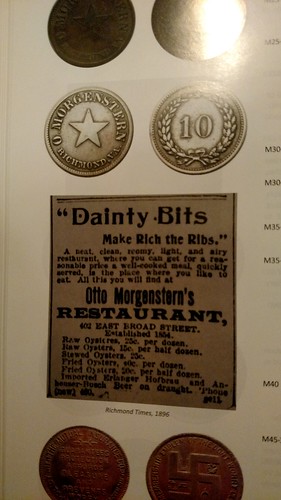
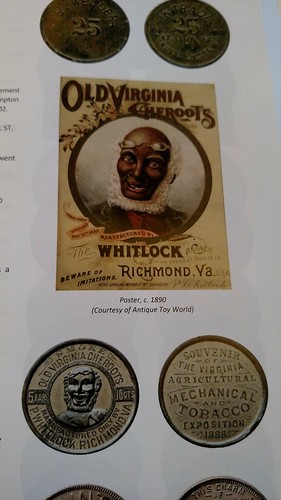
Eric adds:
The second item I brought was an imitation $50 slug issued by Thompsons Restaurants in 1906. This is one of the earliest of the imitation slugs and really is a neat thing. Humbert/USAOG slugs are pretty much near the top of my all-time "dream" coins - ever since I was a kid growing up in California I had always wanted one of these massive 2 1/2 ounce hunks of gold and have been captivated by pioneer/territorial gold ever since. Alas, considering that the real thing costs as much as a nice car, it is highly unlikely I will be able to add one to my collection. Thankfully, courtesy of my cataloging for Stack's Bowers, I have been at least able to write about the coins. However, a fascinating sideline are these imitation slugs, especially the earlier ones. I am still just beginning in my collection (the only other one I have is a high grade 1915 Pan-Pac Brinker piece), but so far it has been quite rewarding.
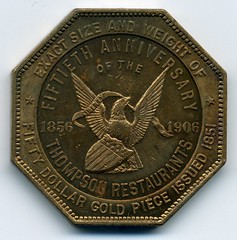
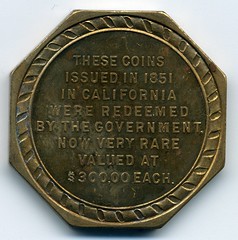
Eric and I also discussed his work as a part-time cataloguer for Stack's Bowers, where he's enjoying the opportunity to do the historical research for some really great coins. The selections in the next article are all lots that he recently worked on. Well done!
Other topics of discussion at my end of the table included the 1980 coin boom and subsequent bust, a rare ancient coin displayed by Robert, and counterfeit Southeast Asian pieces that fooled even the expert dealers.
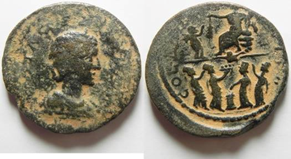
Robert Hoppensteadt provided this information on his coin
Syria, Damascus. Otacilia Severa. Augusta, AD 244-249. AE 28mm . Diademed and draped bust right / Sacrifice to Tyche-Astarte: Tyche- Astarte seated left, holding cornucopia and unknown object (probably a rudder, references describe it as a wreath but on this more clear example it clearly isn't,) river god swimming at feet; before her, Marsyas standing right; in exergue, four figures of Cities (Tyche), wearing turreted crowns; the outer two raising their hands toward Tyche-Astarte; one raising a plate of fruit or other offering (again references call this a wreath but it clearly isn't one and the other known examples don't show it this clearly), and the last pouring a libation on an altar. Cf. BMC 433 (Philip I); cf. AUB 266 (Philip I); Lindgren & Kovacs 2388. Fine/ aVF, green and brown patina, some roughness. Rare reverse type.
Toward the end of the meal the ever-mischievous Gene Brandenburg instructed me to look at the back of the dessert menu. "Two-thirds of the way down." In a section of after-dinner drinks I found what he was looking at: The Godfather, a mix of Amaretto di Saronno and Whiskey. He bought us each one, and it was smooooth. Thanks!
Yet another great evening of numismatic fellowship. I'm very grateful to have such a knowledgeable and friendly group to get together with every month. Forming the group was one of the best numismatic ideas I've ever had (a close second to The E-Sylum itself). Ciao for now, everyone.
To read the earlier E-Sylum article, see:
SOME MORE HALF DIME TOKENS (www.coinbooks.org/esylum_v19n10a17.html)
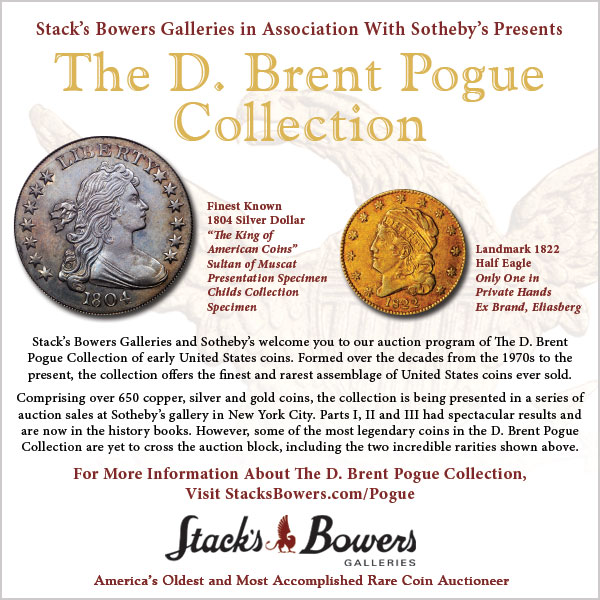
SELECTIONS FROM STACK'S BOWERS MARCH 2016 RARITIES SALE
Lot 13007: Washington Funeral Urn Medal
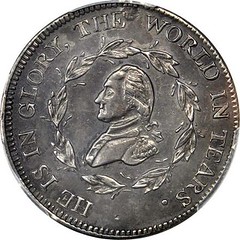
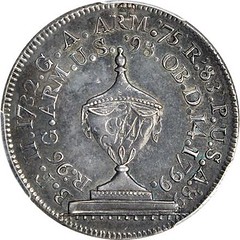
Historic Silver "1799" Washington Funeral Urn Medal "1799" (1800) Funeral Urn Medal. Baker-166A, Fuld Dies 1-B. Rarity- 6. Small Bust. Silver. AU-55 (PCGS). When George Washington died at his Virginia home on December 14, 1799, the fledgling nation was plunged into an extended period of mourning and celebrations of his life for months. Throughout the young United States, many events and funeral processions were held, and along with it a series of privately produced souvenir medals and badges. Among the best known are those issued by the City of Boston in 1800 for the two funeral processions, one on February 11 and a second on February 22.
The medals, struck in silver, white metal, and even gold, were made with two distinct designs: the medals for the first procession bear a skull and crossbones motif, while the medals produced for the later event have a funeral urn instead. The medals were all intended to be worn around the neck from a black ribbon and were all pierced, which as a consequence, very few surviving specimens are found uncirculated or even undamaged. Here is an example that appears to have been purposefully not worn for very long and the hole plugged. Always popular among exonumists and collectors of Washingtoniana, the Boston funeral medals remain a key component of any specialist cabinet of early American medals.
To read the complete lot description, see:
"1799" (1800) Funeral Urn Medal. Baker-166A, Fuld Dies 1-B. Rarity-
6. Small Bust. Silver. (https://auctions.stacksbowers.com/lots/view/3-2LGXR)
Lot 13092: 1795 Draped Bust Silver Dollar
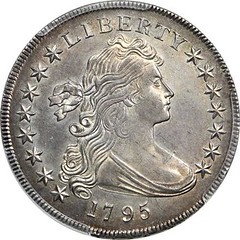

When Henry William DeSaussure became Mint Director in June of 1795, he set two goals: the first to get gold coins to actively circulate and the second to improve the appearance of each denomination with particular attention on the silver coinage. DeSaussure contracted with famed portrait artist Gilbert Stuart to prepare a depiction of Liberty intended to replace Robert Scot's Flowing Hair bust. Stuart's design, believed to have been a drawing of Ann Willing Bingham of Philadelphia, was then transferred into plaster models and punches by John Eckstein for Scot. Eckstein also prepared improved versions of the Small Eagle reverse punches which showed the eagle in intricate detail and style. For this work Eckstein was paid $30 in September. The resulting Draped Bust Small Eagle silver dollar is often heralded as a masterpiece from the early United States Mint, with Eckstein "deserving of a niche in the Pantheon of numismatic notables," as Q. David Bowers writes in The Encyclopedia of United States Silver Dollars: 1794-1804. De Saussure's tenure at the Mint was very short; in October of that same year he resigned his position in October 1795 due in part to illness and general dissatisfaction. While only there for the a few months, he made a long-lasting impression on the nation's coinage. While the Small Eagle reverse would only be employed until 1798, the Stuart/Eckstein Draped Bust was used for the rest of the series until coinage of silver dollars was suspended sometime in 1804.
Two different die combinations were used for the new design. The die pair believed to have been struck first is the so-called Off-Center Bust variety, BB-51, which features Liberty appearing too far to the left from the center, a position used only on this die pair. This positioning was corrected to a more aesthetically pleasing centered location on the second variety, the BB-52 pair. The precise number struck and timing of each variety is unclear. Mint records from the time are not as thorough as scholars would prefer and much of what can be determined is conjecture. The commonly cited mintage figure of 42,738 is believed to be only a portion of the overall total of the 1795 Draped Bust Small Eagle dollars. Bowers posits that somewhere in the vicinity of 100,000 coins were produced of both BB-51 and BB-52 and that while the first deliveries likely took place in October, the later deliveries could have extended into 1796. In fact, the reverse die used for BB-52 was used as late as 1798, lending credence to this being the later of the two varieties.
To read the complete lot description, see:
1795 Draped Bust Silver Dollar. Draped Bust. BB-52, B-15. Rarity-2
(https://auctions.stacksbowers.com/lots/view/3-2LGTH)
Lot 13198: 1799 Capped Bust Right Eagle

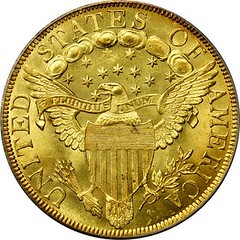
The Mint Act of 1792 established the eagle to be the fundamental basis for America's gold coinage which would be used in international commerce as an economic ambassador for the young nation. It was not until 1795 that coinage of the denomination commenced. Designed by Robert Scot, the obverse of the new coin bore a representation of Liberty facing right flanked by stars while wearing a cloth freedman's cap, with the legend LIBERTY above and the date below. The reverse featured an elegant yet somewhat scrawny eagle with spread wings holding a wreath in its beak, all the while clutching a palm frond in its talons. This simple and attractive design was used for all of three years until Scot completely redesigned the reverse to put forth more powerful and dramatic imagery.
Scot's Heraldic Eagle reverse was based on the obverse of the Great Seal of the United States: in the center is a large eagle with outstretched wings and legs and the national shield across its breast. In its left talon is a clutch of arrows and in its right talon an olive branch of peace. The placement of the arrows in the left or sinister claw stands in contrast to the Great Seal, where the olive branch takes that position of honor. Scot may have not have been aware that this placement of the arrows conveys a more warlike posture in the language of heraldry. In the eagle's beak is a ribbon inscribed E PLURIBUS UNUM. Above its head is an array of 13 stars surmounted by an arch of clouds. The entire design is surrounded by the legend UNITED STATES OF AMERICA. The Heraldic Eagle reverse would be used until 1804 when production of the eagle was suspended for the next 34 years.
In this year, the production of the eagle was stepped up to significant levels after having been struck in modest quantities since its inception. According to Mint records, 37,449 coins were struck in two major obverse design varieties, Small Stars and Large Stars. A total of six obverse and six reverse dies were employed in a total of ten die combinations: eight die pairings for the Small Stars variety and only two pairings for the Large Stars. Of the two major varieties of the 1799 eagle, the Small Stars type is widely thought to have been the first struck and is the slightly scarcer of the two, albeit not by much. At some point the Small Stars punch with long and thin points broke and a new punch was prepared with starts that shorter but much "fatter and puffier," as Garrett and Guth note. The resultant obverse die, Bass-Dannreuther Die 6, was mated to two reverse dies Bass-Dannreuther Die E and Die F, and used for the remainder of the year, producing an estimated 13,000 to 18,000 coins from these two pairs.
To read the complete lot description, see:
1799 Capped Bust Right Eagle. BD-10, Taraszka-22. Rarity-3. Large Obverse
Stars. (https://auctions.stacksbowers.com/lots/view/3-2LFVD)
Lot 13247: 1836 Pattern Gold Dollar
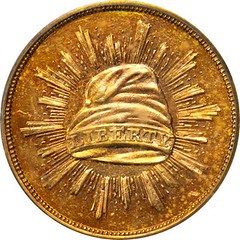
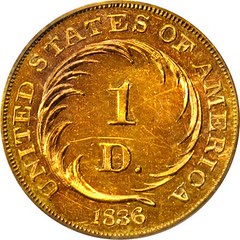
1836 Pattern Gold Dollar. Judd-67, Pollock-70. Rarity-5. Gold. Plain Edge. Proof-63 Cameo (PCGS).
Obv: A liberty cap surrounded by a glory or sunburst, which design is similar to that used on certain coins of the Republic of Mexico. The band of the cap is inscribed LIBERTY. Rev: A coiled palm frond encircles the denomination 1 D. with the legend UNITED STATES OF AMERICA around the border and the date 1836 below.
When Alt Christof Bechtler along with his sons opened his mint in Rutherfordton, North Carolina in 1831, he introduced a new type of coin, the gold dollar. As the Bechtlers became progressively more successful and their coins more widely accepted, Mint officials began taking an interest in their coins. They found that the Bechtler's coins were eagerly accepted in the region and were of good quality and weight, including the gold dollar. While the success of the Bechtler Mint eventually led to the establishment of mints in Charlotte and Dahlonega in 1838, officials were also taking their first tentative steps into launching a gold dollar of their own. in 1836, Treasury Secretary Levi Woodbury tried to convince Mint Director Robert Maskell Patterson to initiate a project to develop such a coin. Patterson, on the other hand, had no interest in striking a gold dollar, arguing that only "second-rate countries issued gold coins of such small size," as Q. David Bowers writes in his guide book to the denomination. With great reluctance, Patterson relented and directed Christian Gobrecht to design a pattern for the denomination. The obverse of Gobrecht's pattern gold dollar bore a striking resemblance to the "Libertad" coinage from Mexico of the time with the cap and rays motif. The reverse was a simple palm frond arranged in a circle surrounding the denomination. David Akers in his work on gold patterns states that 10 to 15 of the pieces were struck, however, additional research bolstered by certification figures puts the number closer to 30 to 40.
The design was widely praised and considered a success but ultimately the project died on the vine, no doubt as a result of Patterson's ambivalence. It would not be until 13 years later until an official United States gold dollar would see general circulation. In 1844, examples were struck from the same dies as the originals but in a gold/silver alloy and again in 1859 a few more restrikes were made, with at least one of them known overstruck on an 1859 gold dollar.
With its minimalist yet aesthetically pleasing design, Gobrecht's pattern gold dollars have long generated intense interest in the collecting community. One of the earliest appearances at auction occurred in 1855 when Bangs, Brother & Company of New York sold an example for $5.75.
To read the complete lot description, see:
1836 Pattern Gold Dollar. Judd-67, Pollock-70. Rarity-5. Gold. Plain
Edge. (https://auctions.stacksbowers.com/lots/view/3-2LGEZ)
Lot 13250: 1849 Miners' Bank $10
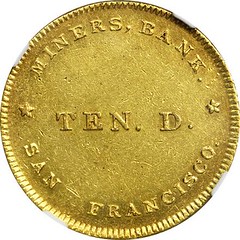
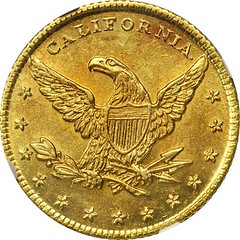
Undated (1849) Miners' Bank $10. K-1. Rarity-6. Copper Alloy, Plain Border. MS-62 (NGC).
One of the early banking concerns of San Francisco, the Miner's Bank was established by the brokerage firm of Wright & Co., headed by partners Stephen Wright, Samual Haight, James Wadsworth, and John Thompson. Many details are scarce including precisely when both the bank and the brokerage firm commenced business, something made especially difficult considering the various other enterprises the partners were engaged at the same time. Intriguingly, an issue of bank notes issued by the Miner's Bank is known dated March 1, 1849, predating California's constitutional prohibition against currency as ratified in November of that year.
It was not until July of 1849 that the Miner's Bank officially announced that it had opened its doors to business at its location on the corner of Washington and Kearney Streets. Evidently the firm had planned an issue of gold coins early on because the next month, they petitioned the Collector of the Port of San Francisco to grant permission to issue $5 and $10 coins in payment of import duties, even though the Customs House would not accept such pieces. Even though their petition was denied, the Miner's Bank went forward with the striking of coins in hopes to alleviate the specie shortage of the region as well as make a small profit.
Because the bank did not have their own assay and refining equipment on their premises, the coins were struck at a different facility, most likely by the assay firm of Broderick & Kohler based on the testimony of James Wadsorth at a trial in which Broderick & Kohler were defendants where Wadsworth states that they produced the coins for the Miner's Bank. Only the $10 coins were produced in two different alloys, one with the gold alloyed with copper and another with silver.
The issue appears to have been fairly sizable and initially the pieces enjoyed some success. However, things changed when while the bank was in the midst of a reorganization, the assayer for the New Orleans Mint examined a Miner's Bank $10 coin and found it was significantly underweight and worth only $9.65. The news spread quickly, the firm dissolved in January of 1850 and by April of the same year the Daily Alta California was reporting that, "The issue of the Miners' Bank is a drug on the market. Brokers refuse to touch it at less than 20 percent discount."
As with many of the first of the privately issued territorial gold coins, large numbers of the coins later ended up in the melting pots of the United States Assay of Gold, and not long after that those of the San Francisco Mint.
To read the complete lot description, see:
Undated (1849) Miners' Bank $10. K-1. Rarity-6. Copper Alloy, Plain
Border. (https://auctions.stacksbowers.com/lots/view/3-2LFB7)

FAKE PROOF 2015-W AMERICAN EAGLES SURFACE
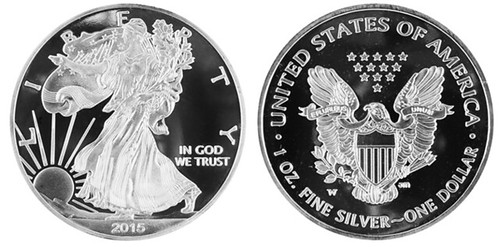
The latest counterfeit to infiltrate the collector market is a fake Proof 2015-W American Eagle silver dollar that appeared at a Florida coin show in February.
Reports have also surfaced of several other different Proof dates also appearing, with 2013 and 2014 pieces among them.
Examples are also reportedly being offered through online outlets.
The counterfeits are offered housed in original U.S. Mint packaging with genuine government-issued certificates of authenticity.
The counterfeit 2015 coin was reported March 7 to Coin World by F. Michael “Skip” Fazzari, a numismatist with Independent Coin Graders in Tampa, Fla.
“The coins are good enough so that a dealer opening the box to make sure a coin was inside would see a blazing Proof,” Fazzari said. “However, a close naked-eye inspection by a bullion dealer would probably be enough to detect a scam,” he said.
Fazzari surmises genuine Mint packaging could have been acquired on eBay or at a coin show where packaging is sold separated from its contents, by dealers or collectors.
The empty boxes, still often containing the certificate of authenticity, remain after the coins are removed, often for submission to a third-party grading service, according to Fazzari.
Among the diagnostics, the counterfeit is out of tolerance, Fazzari said. Fazzari said the counterfeit weighs 30.54 grams compared to the genuine standard of 31.101 grams. The diameter of the fake coin is 39.77 millimeters versus 40.6 millimeters for the genuine silver Proof.
The counterfeit did not test positive for silver or copper using an electronic metals analyzer, Fazzari said. The fake has a specific gravity of 8.4, but currently its metallic composition is unknown.
Although crudely manufactured, Fazzari said the counterfeit is close enough in general appearance to a genuine coin “to fool the average collector or first-time buyer.”
Fazzari took close-up photographs detailing the differences of the counterfeit at specific locations compared with a genuine Proof 2015-W American Eagle silver dollar.
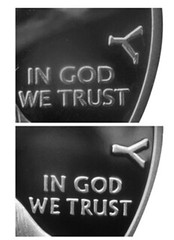 Buyers should also examine lettering on the obverse of the coin. The Y in LIBERTY appears with serifs on the fake, but is sans serif on the
genuine coin.
Buyers should also examine lettering on the obverse of the coin. The Y in LIBERTY appears with serifs on the fake, but is sans serif on the
genuine coin.
The overall surface appearance on the fake’s obverse is granular, compared with the genuine coin’s more satiny-looking finish.
To read the complete article, see:
Counterfeit Proof
2015-W American Eagle silver dollar surfaces at show (www.coinworld.com/news/us-coins/2016/03/counterfeit-silver-proof-
2015-american-eagle-dollar.all.html)

FINDING BAR KOKHBA COINS IN KENTUCKY (OR NOT)
In the last few weeks, I have been preparing a gift of my personal coin collection to the American Numismatic Society. Among the coins was a fascinating piece that is an exact twin to one of the most notorious incidences of numismatic fraud—either actual or accidental— that has occurred in the United States. This story continues to be circulated, and I receive questions about the Bar Kokhba coins found in Kentucky on a regular basis.
Here is the background: In 1952, Robert Cox, a hardware store operator from Clay City, Kentucky, found an exotic coin in a pen he was using for pigs just outside of town along Kentucky Highway 15. The pig pen was part of a field that he had plowed the summer before. It was the first time older residents of the city could remember that this land had ever been turned over. He seemed an honorable man and had nothing to do with ancient coins, and it appears that Mr. Cox legitimately found the coin just where he said he found it.
Clay City is about 40 miles east of Lexington, Kentucky. Equally fascinating is that two other Bar Kokhba coins were discovered in different Kentucky towns.
The rest of the story involves a number of well known scholars who refused to believe other expert numismatists, and has such a long history that it is often repeated as a “true story” today.
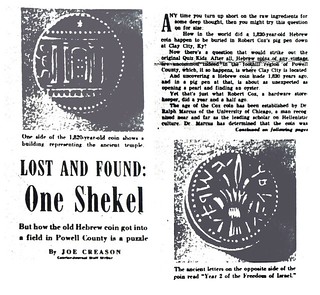
Kentucky newspaper reports
Almost 15 years ago Haim Gitler, current chief curator of archaeology and curator of numismatics at The Israel Museum, and I both received communications from Dr. Fred Coy Jr., an economist at Ohio State University.
Dr. Coy sent us photographs of the actual Clay City coin discovered in 1952 by Robert Cox. He told us that a man named Ya’akov Meshorer had said it was fake back in 1978. But he wanted to check this information to make certain that Meshorer knew what he was talking about.
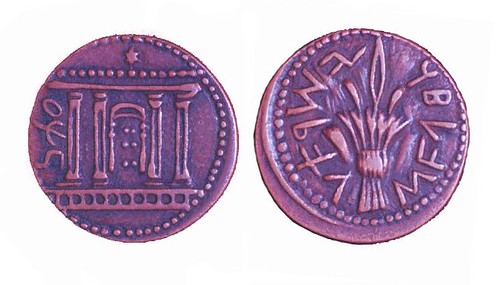
Gitler and I both immediately agreed with Meshorer and stated that this coin was a fake, not even a forgery, but a kind of a fantasy copy.
These observations are second nature to anybody who has ever seriously studied Bar Kokhba coins. But here I have discussed a parade of esteemed University Professors who have been bickering back and forth about this coin since it was discovered in 1952. And we have also learned that the other two so-called Bar Kokhba coins from Kentucky are of the exact type as this one. A photograph accompanying this article depicts an exact duplicate of the coin found in Louisville in 1967
My research at the British Museum has uncovered a lead cast of this very type of Bar Kokhba fake, which was presented to The British Museum in 1922 by Spink and Sons as a replica. Therefore, the original must be somewhat older than that.
My best bet is that this was a souvenir given away by a Bible marketing company in the early 1900s and hundreds or even thousands were passed through the American South. I have personally seen more than 50 of them.
The stories around these coins represent wishful thinking by American Bible Belt scholars. Wouldn’t it just be so interesting if the people in the United States were directly descended from Jews who came to our shores not long after the time of Jesus….sigh.
But it isn’t so and I am glad to report this story over and over to remind collectors that the authenticity of a coin that has not been found in a licensed archaeological excavation is only as good as the expert who is evaluating it!
To read the complete article, see:
FINDING BAR KOKHBA COINS IN KENTUCKY (OR NOT)
(www.anspocketchange.org/barkokhba/)

ALABAMA BRINK'S WORKER STEALS $200,000 IN QUARTERS
Federal prosecutors in Alabama say a former armored transportation company worker has agreed to plead guilty to stealing nearly $200,000, all in quarters.
The U.S. attorney's office in Birmingham says 49-year-old Stephen Lancaster Dennis of Harpersville agreed to plead guilty to theft.
A statement released Monday about the case says Dennis has to repay $196,000 to Brink's Co., the armored transportation company he worked for at the time of the heist.
Prosecutors say Dennis was a money-processing manager at a Brink's facility in Birmingham, where coins were stored for the Atlanta Federal Reserve Bank. They say the man took 784,000 quarters in early 2014 by using beads to fill bags that were supposed to contain $50,000 each in quarters.
To read the complete article, see:
Prosecutors: Alabama man stole $200,000 in
quarters (www.kmov.com/story/31409628/prosecutors-alabama-man-stole-200000- in-quarters)
THE BOOK BAZARRE
THE HISTORY OF THE NLG'S CLEMMY AWARD
The initials that appear after the names of many of the authors of numismatic articles or columns are those of the Numismatic Literary Guild (N.L.G.).
My first contact with the organization came about when a letter was received dated March 2, 1968.
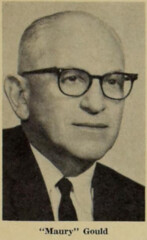 “Dear Clem: A number of years ago I thought of forming an organization like the Numismatic Literary Guild. When I heard that one was in the
process of formation in California, I readily agreed to assist in any way possible.
“Dear Clem: A number of years ago I thought of forming an organization like the Numismatic Literary Guild. When I heard that one was in the
process of formation in California, I readily agreed to assist in any way possible.
The enclosed information is self-explanatory and there are no dues involved with the organization, and only certain categories are available for membership.
We hope to have you with us as a charter member in the very select group which will comprise this organization, and I am enclosing application blank.
I believe that there are many directions this group can go to help numismatics, authors, museums, etc. Kindest regards. Maurice
(Maury)
M. Gould.”
My application was completed and sent back within a couple of days with the following memo:
“March 5, 1968 Dear Gang: Notice that I did not miss the hand rail while making the jump to the N. L.G. band wagon. This could be a big thing to publishers, editors, writers and it might even help a columnist.
N.L.G. (Nobody Loves a Goof) will have the greatest social gatherings in the hobby. First one at the bar, without his card, has to buy the next round.
Numismatic writers have problems that are best solved by their own ilk. I hope that the membership is kept within the circle of the clan.
Bet that I am one of the pure columnists in the bunch. Most graduate to write or editor, but I haven’t emptied enough waste paper baskets to graduate that high.”
There was one prophetic statement in the letter — about the N.L.G. having the greatest social gatherings in the hobby. My original “buy law” has only caught on with a few members of the N.L.G.
Within a couple of months of organization, one of the early Newsletters mentioned something about my activities and this letter was received from the Guild office.
“Dere Cur — Sir: Tank U 4 writin bout us litvaree Gild Guyz. C U at Kunvenshun. Hope U no mind wryte up bout U in thiz. Lee (Lee Martin, Editor of the Newsletter).”
That fall in San Diego at the American Numismatic Association annual convention, the N.L.G. had their first organizational meeting. At the end of the meeting, a forty pound ancient typewriter painted with gold was given to me as the first annual award. It was promptly dubbed “The Clemmy Award” by James Miller, the publisher of COINage Magazine, and the name has stuck.
The ancient typewriter was dug out of a California junk yard after several weeks of search by Gordon Greene, the current treasurer of the Guild. He also claims that it took several cans of gold paint to make the ugly duckling a beautiful swan (?). The long grind of going across country from convention to convention caused it to be retired after Maury Gould received it in 1973. The typewriter is now resting at the American Numismatic Association Museum in Colorado Springs.
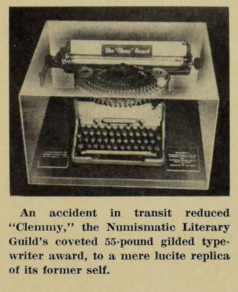 A plastic award is now given to the new “Clemmy” winners at the annual N.L.G. meeting. Since 1969 the typewriter has been awarded to Ed
Rochette, Lee Martin, Margo Russell, Virginia Culver, Maurice Gould, Eva Adams and Ray Byrne in that order.
A plastic award is now given to the new “Clemmy” winners at the annual N.L.G. meeting. Since 1969 the typewriter has been awarded to Ed
Rochette, Lee Martin, Margo Russell, Virginia Culver, Maurice Gould, Eva Adams and Ray Byrne in that order.
On November 29, 1975, the first member of the award winning group died in Los Angeles — Maurice M. Gould. Maury was a collector, professional numismatist, author and lecturer for 57 of his 66 years. He was starting his second term as a member of the Board of Directors of the American Numismatic Association.
Maury Gould left a lot of marks in this world, but none will be more important than the mark of a numismatic writer — N.L.G. — after an authors name. Maury was a founder of the Numismatic Literary Guild and sponsored my charter-life membership in the organization.
It may be important to say that I was a friend to him, but it is probably more important to say that he was a friend to me.
To read the complete article, see:
https://archive.org/stream/centinel23n3cent#page/16/mode/2up

YOUTH GROUP VISITS BRITISH MUSEUM NUMISMATICS SECTION
Money. It doesn’t grow on trees and can’t buy you love or happiness, but apparently it makes the world go round. The subject of so many songs and clichés, money dominates and determines our life experience, even our identity.
This much is obvious to those who attend the New Horizon Youth Centre, a London-based charity that supports homeless and at risk young people, and aims to help them create a more positive future for themselves. Part of New Horizon’s Social Enterprise Project offers young people the chance to improve on essential life skills, such as communication and confidence, by providing workshops in partnership with organisations like the British Museum, and with artists like myself.
So this was how a group of bright young people from New Horizon and I came to be gathered around a table in the British Museum, talking about money, with the Citi Money Gallery Education Manager, Mieka Harris, and the Curator of the Citi Money Gallery, Ben Alsop as part of the Citi Money Gallery Education Programme.
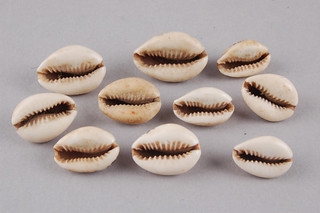 Our discussions were sparked off by some intriguing handling objects, selected by the curator from the Museum’s extensive collection of
coins and currencies. As we lifted the lid on boxes of enigmatic artifacts, money started to appear in all sorts of unexpected guises, unusual
materials, shapes and sizes. Large heavy crosses of copper weighed alongside tiny slivers of silver, and exotic shells rolled out next to green
knives and pieces of fine silk cloth. The diversity of the designs was remarkable, highlighted by these examples of the different material forms that
money has adopted throughout history and across the world. In each of these tokens, we glimpsed something of the time and culture that had originally
issued them for commercial exchange.
Our discussions were sparked off by some intriguing handling objects, selected by the curator from the Museum’s extensive collection of
coins and currencies. As we lifted the lid on boxes of enigmatic artifacts, money started to appear in all sorts of unexpected guises, unusual
materials, shapes and sizes. Large heavy crosses of copper weighed alongside tiny slivers of silver, and exotic shells rolled out next to green
knives and pieces of fine silk cloth. The diversity of the designs was remarkable, highlighted by these examples of the different material forms that
money has adopted throughout history and across the world. In each of these tokens, we glimpsed something of the time and culture that had originally
issued them for commercial exchange.
While no one in our group could imagine carrying shells in their wallet or swapping copper crosses for goods and services around London, the idea of money as a versatile designed object appealed to everyone. We took a closer look at our own contemporary currency, observing the intricate detail that ensures the designs are as secure as they are symbolic, and a powerful representation of our national identity.
I invited the group to express some of their ideas visually, by designing their own coins. What would they choose to represent if they were creating their own monetary tokens?
After sketching out some of their initial thoughts on paper, the group were given the chance to scribe these designs onto wax discs which would later be cast into bronze and displayed at the British Museum.
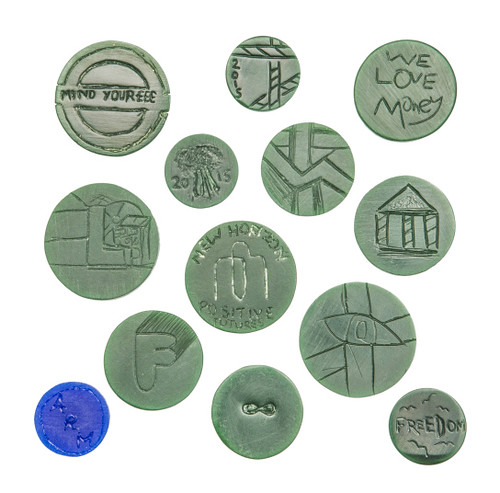
From representations of surveillance and state control to symbols of infinity, freedom and love; from expressions of financial lack to being financially on track, the effects of money inscribed by the young people were insightful and revealing. Some coins humorously commented on the cost of living with the words ‘arm’ and ‘leg’ while other designs were abstract, like the very notion of money.
Experimenting with these newly-introduced skills of carving and scribing into casting wax, the New Horizon participants deftly worked the material to produce these highly creative results. You can already see some of these personal coin tokens, now cast into bronze, on show in the Citi Money Gallery, located in Room 68 of the British Museum, alongside a selection of the Money No Object wearable prototypes.

After such a fantastic day working with these brilliant young people from the New Horizon Youth Centre and inspiring staff from the British Museum, I am really excited to be continuing this collaboration over the coming months, and exploring the far-reaching significance of money.
To read the complete article, see:
Mind your money: money matters
(http://blog.britishmuseum.org/2016/03/11/mind-your-money-money- matters/)
IKEA’S UBIQUITOUS BILLY BOOKCASE DESIGNER DIES
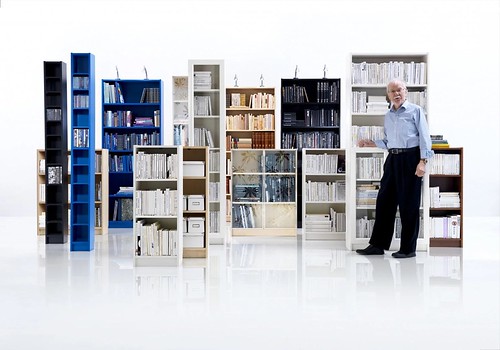
Gillis Lundgren, an industrial designer who helped make Ikea the largest furniture retailer in the world with his no-frills designs, most notably the Billy bookcase that millions of frugal book collectors have used to build their home libraries, has died at 86.
Kajsa Johansson, an Ikea spokeswoman, confirmed his death, describing him as “a man full of ideas that he quickly turned into practical products,” but gave no other details.
Mr. Lundgren joined Ikea in 1953 as the company’s fourth employee and advanced to become its first design manager. A draftsman with training in graphics, he designed hundreds of Ikea’s simple, portable furnishings and was credited with creating the company logo, whose blue and yellow colors were taken from the Swedish flag.
Although few of those people are likely to know Mr. Lundgren’s name, all of them are or will soon become acquainted with perhaps his most significant contribution to the Ikea business model: “flat-pack” furniture.
Ikea was not the first company to employ the now-ubiquitous system, but Mr. Lundgren was credited with perfecting it for Ikea’s purposes. He said the idea came to him early in his career. Ikea had recently entered the furniture market, he recalled, and “storage space became an issue.”
Today, shoppers peruse fully assembled Ikea wares in showrooms and on the company’s website but take home (or order for delivery) boxes that contain the products in pieces, neatly stacked, to be assembled on arrival. The flat-pack system allows Ikea to save money by moving its products more efficiently and customers to save money, although not time, by providing the labor.
Many shoppers who enter an Ikea warehouse, no matter how few their belongings or how small their home, have at least a few books to place on a shelf and at least one wall against which to rest it. Those shoppers may not, however, have a large amount of money to part with. And so they may go home with a Billy bookcase, created by Mr. Lundgren and introduced in 1978.
He was said to have drawn the design on a napkin.
“Ideas are perishable,” he once remarked, “and you have to capture the moment as soon as it arrives.”
Billy’s plain shelves of varying heights and widths proved imperishable and remain largely unchanged from Mr. Lundgren’s original design. Because of improvements in production efficiency, the product line costs less today than it did at its debut, with one basic model on sale for $69.99.
“I want to create solutions for everyday based on people’s needs,” Australian newspapers quoted him as saying. “My products are simple, practical and useful for everyone, no matter how old you are or what your life situation.”
To read the complete article, see:
Gillis Lundgren, designer of Ikea’s ubiquitous Billy bookcase, dies at 86
(www.washingtonpost.com/world/europe/gillis-lundgren-designer-of- ikeas-ubiquitous-billy-bookcase-dies-at-86/2016/03/10/a1ec674a-
e60b-11e5-a6f3-21ccdbc5f74e_story.html)
THE BOOK BAZARRE
THE WORLD'S MOST BEAUTIFUL BANKNOTES
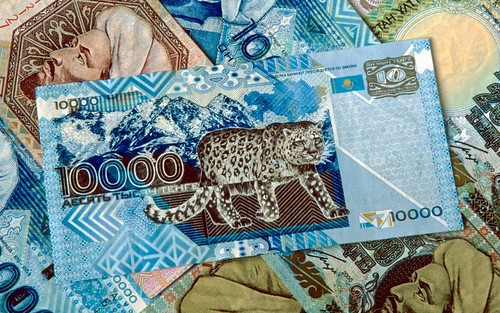

South African Rand banknotes
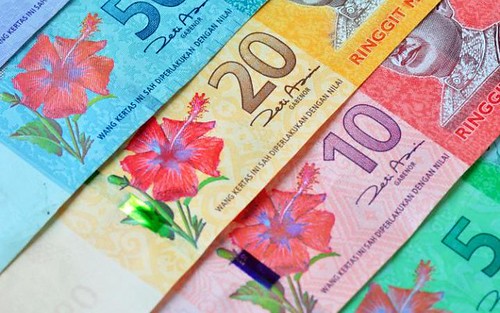
Malaysian ringgit banknotes
To read the complete article, see:
The world's
most beautiful currencies, in pictures (www.telegraph.co.uk/expat/money/the-worlds-most-beautiful-
currencies-in-pictures/south-african-banknotes/)
FEATURED WEB SITE: RENAISSANCE OF THE CAST MEDAL
This week's Featured Web page is on the renaissance of the cast medal in nineteenth century France, from the web site of David and Constance Yeats. Thanks to Ben Weiss for posting the link on his own site, www.historicalmedals.com.The medal as we know it today had its origins in the Italian Renaissance with the circular bronze commemorative portraits produced by Pisanello (c. 1395-1455) during the mid-fifteenth century. Medals are often viewed in a numismatic context because they share certain obvious characteristics with coins. Both are round, made of metal, and exhibit a portrait on the front (obverse) and an allegorical or narrative scene relating to that portrait on the back (reverse). In general, coins are produced in great numbers by a central political authority and are meant to circulate socially as a medium of exchange. Medals, however, have no intrinsic value. They are produced for many purposes: to celebrate famous people, to mark important social or political events, or to memorialize personal milestones, such as births, marriages and deaths. Until the seventeenth century, medals were often used as articles of personal adornment, attached to clothing or worn around the neck. As intimate sculpture in a double-sided relief format, medals have always been something to hold and turn in the hand--personal objects for aesthetic and intellectual contemplation.
A medal can either be struck or cast--techniques developed in the classical world and perfected during the Italian Renaissance. The process of striking consists first of the preparation of the desired images on two dies followed by the impression by force of these dies onto a prepared metal blank. In antiquity and throughout the Middle Ages this force was provided by the simple act of hammering. The invention of the screw press in early sixteenth century Italy enabled medals to be struck with greater speed and control. The result is an object sharply and precisely defined, but often rather dry and lacking in sculptural elegance. Not surprisingly, striking was, and is today, the method utilized for mass production of both coins and medals. Casting requires the preparation of two original uniface models--the obverse and reverse--in wax, plaster, or less commonly, wood or stone. These models are utilized to create negative molds in a soft material such as terracotta or gesso. Once the molds have dried, they are fitted together leaving channels into which the molten metal is poured. After cooling, the medal in its raw state is removed from the mold. At this stage a careful hand finishing is required which includes filing, chasing, and often the application of chemically based patinations and thin coats of lacquer. The final result is a unique work of art, with examples of the same medal exhibiting subtle variations in color and surface detail.
The earliest medals in sixteenth century France were produced by goldsmiths working in a style which combined the native Gothic heraldic tradition with an obvious awareness of Italian Renaissance portraiture. From the outset, the production of medals in France was highly dependent on the patronage of the crown. This may be viewed in comparison to the early history of the medal in Italy, where artists relied more on the commands of private patrons, resulting in the possibility of greater artistic freedom. The invitations extended by François I (1494-1547) to Italian artists and craftsmen, among them Benvenuto Cellini and the aged Leonardo, to help embellish his court at Fontainebleau demonstrate the lure that Italian aesthetic innovation had in France.
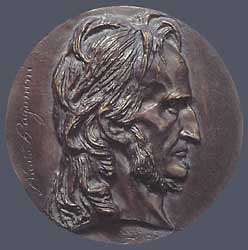
www.dcyates.com/medals.asp


